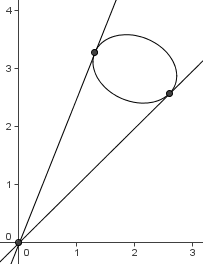Difference between revisions of "2004 AMC 12B Problems/Problem 21"
m (→Solution) |
m (→Solution) |
||
| Line 15: | Line 15: | ||
Rearranging by the degree of <math>x</math>, | Rearranging by the degree of <math>x</math>, | ||
<cmath>(3m^2 + m + 2)x^2 - (20m + 11)x + 40 = 0</cmath> | <cmath>(3m^2 + m + 2)x^2 - (20m + 11)x + 40 = 0</cmath> | ||
| − | Since the line <math>y=mx</math>, we want the discriminant, | + | Since the line <math>y=mx</math> is tangent to the ellipse, we want the discriminant, |
<cmath>(20m+11)^2 - 4\cdot 40 \cdot (3m^2 + m + 2) = -80m^2 + 280m - 199 </cmath> | <cmath>(20m+11)^2 - 4\cdot 40 \cdot (3m^2 + m + 2) = -80m^2 + 280m - 199 </cmath> | ||
to be equal to <math>0</math>. We want <math>a+b</math>, which is the sum of the roots of the above quadratic. By [[Vieta’s formulas]], that is <math>\frac{280}{80} = \frac{7}{2} \Rightarrow \mathrm{(C)}</math>. | to be equal to <math>0</math>. We want <math>a+b</math>, which is the sum of the roots of the above quadratic. By [[Vieta’s formulas]], that is <math>\frac{280}{80} = \frac{7}{2} \Rightarrow \mathrm{(C)}</math>. | ||
Latest revision as of 15:23, 13 March 2023
Problem
The graph of ![]() is an ellipse in the first quadrant of the
is an ellipse in the first quadrant of the ![]() -plane. Let
-plane. Let ![]() and
and ![]() be the maximum and minimum values of
be the maximum and minimum values of ![]() over all points
over all points ![]() on the ellipse. What is the value of
on the ellipse. What is the value of ![]() ?
?
![]()
Solution
![]() represents the slope of a line passing through the origin. It follows that since a line
represents the slope of a line passing through the origin. It follows that since a line ![]() intersects the ellipse at either
intersects the ellipse at either ![]() or
or ![]() points, the minimum and maximum are given when the line
points, the minimum and maximum are given when the line ![]() is a tangent, with only one point of intersection. Substituting,
is a tangent, with only one point of intersection. Substituting,
![]() Rearranging by the degree of
Rearranging by the degree of ![]() ,
,
![]() Since the line
Since the line ![]() is tangent to the ellipse, we want the discriminant,
is tangent to the ellipse, we want the discriminant,
![]() to be equal to
to be equal to ![]() . We want
. We want ![]() , which is the sum of the roots of the above quadratic. By Vieta’s formulas, that is
, which is the sum of the roots of the above quadratic. By Vieta’s formulas, that is ![]() .
.
See also
| 2004 AMC 12B (Problems • Answer Key • Resources) | |
| Preceded by Problem 20 |
Followed by Problem 22 |
| 1 • 2 • 3 • 4 • 5 • 6 • 7 • 8 • 9 • 10 • 11 • 12 • 13 • 14 • 15 • 16 • 17 • 18 • 19 • 20 • 21 • 22 • 23 • 24 • 25 | |
| All AMC 12 Problems and Solutions | |
The problems on this page are copyrighted by the Mathematical Association of America's American Mathematics Competitions. 










